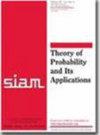论连续和的分布与普罗霍罗夫距离的接近性
IF 0.6
4区 数学
Q4 STATISTICS & PROBABILITY
引用次数: 0
摘要
概率论及其应用》第 69 卷第 2 期第 217-226 页,2024 年 8 月。 设 $X,X_1,\dots,X_n,\dots$ 是独立同分布的 $d$ 维随机向量,其共同分布为 $F$。假设 $F_{(n)}$ 是归一化随机向量 $X/\sqrt{n}$ 的分布。那么 $(X_1+\dots+X_n)/\sqrt{n}$ 的分布为 $F_{(n)}^n$(幂是在卷积意义上理解的)。让 $\pi(\,{\cdot}\,,{\cdot}\,)$ 成为普罗霍罗夫距离。我们将证明,对于任意 $d$ 维分布 $F$,存在仅依赖于 $F$ 的 $c_1(F)>0$ 和 $c_2(F)>0$ ,使得 $\pi(F_{(n)}^n,F_{(n)}^{n+1})\leqslant c_1(F)/\sqrt n$ 和 $(F^n)\{A\}。\le (F^{n+1})\{A^{c_2(F)}\}+c_2(F)/\sqrt{n}$, $(F^{n+1})\{A\}\leq (F^n)\{A^{c_2(F)}\}+c_2(F)/\sqrt{n}$ 对于每个伯尔集合 $A$ 和所有自然数 $n$(这里,$A^{\varepsilon}$ 表示集合 $A$ 的 $\varepsilon$-邻域)。本文章由计算机程序翻译,如有差异,请以英文原文为准。
On Proximity of Distributions of Successive Sums with Respect to the Prokhorov Distance
Theory of Probability &Its Applications, Volume 69, Issue 2, Page 217-226, August 2024.
Let $X, X_1,\dots, X_n,\dots$ be independent identically distributed $d$-dimensional random vectors with common distribution $F$. Let $F_{(n)}$ be the distribution of the normalized random vector $X/\sqrt{n}$. Then $(X_1+\dots+X_n)/\sqrt{n}$ has distribution $F_{(n)}^n$ (the power is understood in the convolution sense). Let $\pi(\,{\cdot}\,,{\cdot}\,)$ be the Prokhorov distance. We show that, for any $d$-dimensional distribution $F$, there exist $c_1(F)>0$ and $c_2(F)>0$ depending only on $F$ such that $\pi(F_{(n)}^n, F_{(n)}^{n+1})\leqslant c_1(F)/\sqrt n$ and $(F^n)\{A\} \le (F^{n+1})\{A^{c_2(F)}\}+c_2(F)/\sqrt{n}$, $(F^{n+1})\{A\} \leq (F^n)\{A^{c_2(F)}\}+c_2(F)/\sqrt{n}$ for each Borel set $A$ and for all natural numbers $n$ (here, $A^{\varepsilon}$ denotes the $\varepsilon$-neighborhood of a set $A$).
Let $X, X_1,\dots, X_n,\dots$ be independent identically distributed $d$-dimensional random vectors with common distribution $F$. Let $F_{(n)}$ be the distribution of the normalized random vector $X/\sqrt{n}$. Then $(X_1+\dots+X_n)/\sqrt{n}$ has distribution $F_{(n)}^n$ (the power is understood in the convolution sense). Let $\pi(\,{\cdot}\,,{\cdot}\,)$ be the Prokhorov distance. We show that, for any $d$-dimensional distribution $F$, there exist $c_1(F)>0$ and $c_2(F)>0$ depending only on $F$ such that $\pi(F_{(n)}^n, F_{(n)}^{n+1})\leqslant c_1(F)/\sqrt n$ and $(F^n)\{A\} \le (F^{n+1})\{A^{c_2(F)}\}+c_2(F)/\sqrt{n}$, $(F^{n+1})\{A\} \leq (F^n)\{A^{c_2(F)}\}+c_2(F)/\sqrt{n}$ for each Borel set $A$ and for all natural numbers $n$ (here, $A^{\varepsilon}$ denotes the $\varepsilon$-neighborhood of a set $A$).
求助全文
通过发布文献求助,成功后即可免费获取论文全文。
去求助
来源期刊

Theory of Probability and its Applications
数学-统计学与概率论
CiteScore
1.00
自引率
16.70%
发文量
54
审稿时长
6 months
期刊介绍:
Theory of Probability and Its Applications (TVP) accepts original articles and communications on the theory of probability, general problems of mathematical statistics, and applications of the theory of probability to natural science and technology. Articles of the latter type will be accepted only if the mathematical methods applied are essentially new.
 求助内容:
求助内容: 应助结果提醒方式:
应助结果提醒方式:


